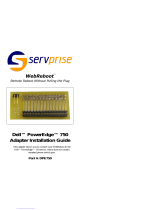System Features
l 1-U rack-mountable chassis.
l Intel®Pentium®4 processor with a speed of at least 2.8 GHz and a front-side bus speed of 800 MHz; or Intel Celeron®processor with a speed of at
least 2.4 GHz and a front-side bus speed of 400 MHz.
l A minimum of 256 MB of PC-3200 DDR400 SDRAM memory, upgradable to a maximum of 4 GB by installing memory modules in the four memory module
sockets on the system board.
l One 64-bit, 66-MHz, 3.3-V PCI-X expansion slot and one 32-bit, 33-MHz, 5-V PCI expansion slot. Both slots support full-height, half-length cards.
l Single integrated drive controller supports up to two SATA hard drives and one optional IDE CD drive or CD-RW/DVD combination drive.
l Optional SCSI RAID solutions support two optional SCSI hard drives.
l Optional SATA RAID solutions (when available).
l Optional remote access controller for remote systems management.
l Optional 1.44-MB, 3.5-inch diskette drive.
l Optional USB flash drive emulates a diskette drive or hard drive.
l One 280-W power supply.
l Two integrated Gigabit Ethernet network adapters, capable of supporting 10-Mbps, 100-Mbps, and 1000-Mbps data rates.
l Three system cooling fans and two power-supply cooling fans.
l Serial connector for console redirection support.
l Security features, including chassis-intrusion detection and keylock on the optional bezel.
l Systems management circuitry that monitors critical system voltages and temperatures. The systems management circuitry works in conjunction with
the systems management software.
For more information about specific features, see "Technical Specifications."
Supported Operating Systems
Your system supports the following operating systems:
l Microsoft®Windows®2000 Server
l Microsoft Windows Server 2003, Enterprise Edition and Web Edition
l Red Hat®Enterprise Linux ES (version 3) and AS (version 3) (when available)
l Novell®NetWare®5.1 and 6.5
Power Protection Devices
Certain devices protect your system from the effects of problems such as power surges and power failures.
l PDU — Uses circuit breakers to ensure that the AC current load does not exceed the PDU's rating.
l Surge protector — Prevents voltage spikes, such as those that may occur during an electrical storm, from entering the system through the electrical
outlet. Surge protectors do not provide protection from brownouts, which occur when the voltage drops more than 20 percent below the normal AC line
voltage level.
l Line conditioner — Maintains a system's AC power source voltage at a moderately constant level and provides protection from brownouts, but does not
protect against a complete power loss.
l UPS — Uses battery power to keep the system running when AC power is unavailable. The battery is charged by AC power while it is available so that
after AC power is lost, the battery can provide power to the system for a limited amount of time—from15minutestoapproximatelyanhour.AUPSthat
provides only 5 minutes of battery power allows you to shut down the system. Use surge protectors and PDUs with all universal power supplies, and
ensure that the UPS is UL-safety approved.
Other Documents You May Need




















